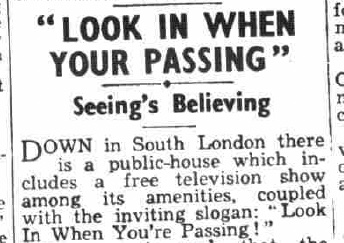OTD in early British television: 20 May 1937

John Wyver writes: At the bottom of column 5 on page 2 of the Thursday 20 May 1937 edition of The Era newspaper was a story headlined ‘Look In When You’re Passing’. Part of the Gaumont British media conglomerate, this weekly journal was almost a house magazine for the theatrical and cinema professions, and it was increasingly turning its attentions to the service from Alexandra Palace that had started six months earlier. In full, this brief news item ran:
Down in South London there is a public-house which includes a free television show among its amenities, coupled with the inviting slogan: ‘Look In When You’re Passing!’ Response is such that the lounge is invariably crowded at the crucial hours and there is as yet no sign of the novelty losing its charm. CEA headquarters, asked if any definite steps had been taken in regard to the licensing-house entertainments, replied darkly that there was ‘something brewing’.
In May 1937 there were almost certainly fewer than 1,000 television receivers in London, and many of these were in dealer’s showrooms. Nor was the south London hostelry exposed in The Era unique in employing a set as an attraction for drinkers. The BBC was relaxed about this, since the television service was desperate to get potential purchasers in front of sets in any way possible.
Moreover, it was far from clear that there were any legal issues involved, and almost certainly not if the public house was not charging for admission. As for the CEA, the Cinematograph Exhibitors Association, which represented the interests of cinema owners, it was only beginning to recognise television as a potential threat.
Two years on, in the summer of 1939, the CEA along with the Variety Artists Association and others, were very actively involved in lobbying against pubs and restaurants showing the BBC’s studio output and newsreels, along with potentially screening the handful of feature films licenced to the new medium. There would also be a tussle over similar screenings of sports outside broadcasts.
But in these early days the presence of television in a pub was little more than a novelty worthy of no more than a filler at the foot of a column of more weighty news.
[OTD post no. 154]
Footnote: in ‘Television and Short-wave World’, April 1937, a report reflected that
‘Among recent purchasers of television receivers are large numbers of owners of licensed premises who are finding them a profitable attraction. It is stated that this class are at present the largest purchasers and that the number of receivers in public houses now exceeds those in the large departmental stores.’
Two years later an estimated 300 restaurants and public houses were equipped with receivers.